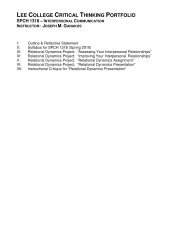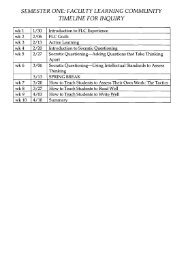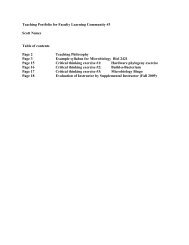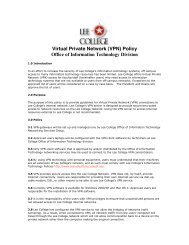Judy Lehmberg (FLC I) - Lee College
Judy Lehmberg (FLC I) - Lee College
Judy Lehmberg (FLC I) - Lee College
You also want an ePaper? Increase the reach of your titles
YUMPU automatically turns print PDFs into web optimized ePapers that Google loves.
Answer: They didn't understand it?<br />
Instructor: Right, no one within the Royal Society understood Mendel's work. They saved it, but no one,<br />
including Darwin, understood it. To get this in context you must understand that at the time the words<br />
chromosome and gene didn't exist and no one knew how traits where inherited until years later. Now we say<br />
that Mendel discovered alternative versions of genes. What is wrong with saying that?<br />
Answer: Mendel didn't know about genes, therefore he must have discovered alternative versions of inheritable<br />
traits.<br />
Instructor: (Drawing a sperm with a little person inside the head of the sperm) To give you an idea of the<br />
knowledge of genetics at the time there where drawings in biology books like this. What is wrong with this<br />
drawing?<br />
Answer: There is not a person inside a sperm?<br />
Instructor: What is in the head of a sperm?<br />
Answer: Chomosomes. Genes.<br />
Instructor: How many?<br />
Answer: One set, or one half the number that would be in a human. You need another set from a mother to<br />
make a whole person.<br />
Instructor: Obviously there were a number of things people did not understand about inheritance at the time.<br />
Just think: Mendel started with very little knowledge, worked for years in isolation from other biologists, never<br />
got any recognition during his lifetime. Imagine spending your adult life doing something that no one else<br />
understood. But he was lucky in one thing. That is, he was lucky in the organism he worked with. What<br />
organism did he study?<br />
Answer: Pea plants.<br />
Instructor: Right. The reason I say he was lucky is that all the visible traits in pea plants are inherited in an easy<br />
to see and easy to understand dominant - recessive manner. Just to give you an idea of how lucky he was, do<br />
know what a hydrangea plant looks like? There is a photo of one in the back of the genetics chapter. For those<br />
of you that read the chapter, the color of hydrangea flowers is determined not by genes, but by what?<br />
Answer: pH of the soil.<br />
Instructor: Now imagine if Mendel had looked at something like hydrangeas.<br />
Instructor: What does P stand for in "P generation"?<br />
Answer: Parents<br />
Instructor: What is the F 1 generation?<br />
Answer: The offspring of the P generation.<br />
28
















